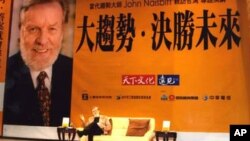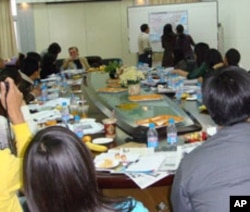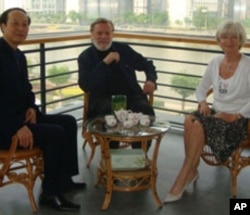How did China transform itself from a poor country to one of the largest economies in the world in just 30 years? To answer that question, American futurist John Naisbitt and his wife, Doris, established the Naisbitt China Institute in that country's Tianjin Province in 2006.
John Naisbitt still remembers China as it was more than 40 years ago when he visited for the first time. "Unbelievably primitive in the 1960s and 1970s," says Naisbitt. "To spend time there now with the most modern cities in the world, the most modern transportation in the world, it's just very hard to comprehend. How did they do it?"
To discover the secret of China's rapid transformation, staff members at Naisbitt's China Institute were asked to monitor the local media: newspapers, radio, television and the Internet.
"To get a picture of what was going on in China, we had to monitor all of China, all the provinces," Doris Naisbitt says. "We had to monitor local news, here is a new school, here, the farmers are creating a cultural center, whatever little things will then make the big picture."
Modern China
Part of that picture includes China's smooth transition from rigid communism to a form of capitalism, a result of reforms instituted by the late Chinese premier Deng Xiaoping in the 1980s.
"I would say communism is left over from the time before Deng Xiaoping. There is a certain connection to communism, which is a totally different one than we as Western people think. One of the sayings that Deng Xiaoping is famous for is, 'It doesn't matter what color the cat is, whatever it is black or white, as long as it catches mice'. They understood well that communism did not serve them, that central planning couldn't bring China out of poverty," Doris Naisbitt says. They were extremely poor and backward 30 years ago. They had to put in the market capitalism, to give the people the opportunity to do what they are talented in and to get China's economy going."
That's what the Naisbitts call the "emancipation of mind", one of the eight pillars of China's new society described in their new book, "China's Megatrends".
"Deng Xiaoping said 'I can't do it. The government can't do it. Only people can do it and we have to move from indoctrination to emancipation,'" says John Naisbitt. "One of the pillars we have, we call "framing the forest and letting the trees grow". In other words, the government frames what's possible or what's to be done, like the special economic zones, but then the people in that frame can contribute however they want to contribute, because it all comes from people."
John Naisbitt calls Deng Xiaoping the founder of the new China. "He's the father and the godfather of this modern China because he never followed the Cultural Revolution," he says. "Some people are beginning to think, and I'm beginning to agree with them, that the Cultural Revolution as horrible as it was, really prepared the ground for the new China because it was so bad that once the people were liberated and released to enhance their own lives, they really went for it."
Pillars of a new society
Other pillars in China's new society, the Naisbitts contend, include giving artists and intellectuals the lead in cultivating people's minds and senses, balancing what's economically possible and socially desirable, playing a new political role in the global community and encouraging economic experimentation.
"Crossing the river by feeling the stones, it was a trial and error," John Naisbitt says. "You're feeling your way across and you feel the stones so you shift your course, maybe back-up a little bit or go forward. That's what they have been doing, starting with the free-economic zone. They had all kinds of ideas: no taxes, special competition about trade and so forth. Those things that worked they stayed with them, the other things, they dismissed as they moved on, feeling their way."
Doris Naisbitt notes that China has also chosen to create its own form of democracy.
"We call what's developing in China vertical democracy because of its structure...top-down directions and bottom up initiatives," she explains. "Over time China's Communist Party has to say goodbye to the name, Communist, because it doesn't reflect what the party really is."
While the Naisbitts point to the new freedoms in Chinese society, such as a focus on creative thinking in education and greater women's rights, other China watchers note that Beijing still maintains tight control over religion, the judicial system and the media, including public access to the Internet. Also, the government's record on human rights, especially its treatment of ethnic Tibetan and Uighur populations, continues to draw widespread criticism from rights groups and the international community.
Global opportunity
But such concerns have not slowed Beijing's extraordinary advance into the global marketplace. China recently became the world's largest exporter, passing Germany, and is expected to soon become the second largest economy in the world, passing Japan. Those developments, Naisbitt says, should encourage the world to look to China as an opportunity, not a threat.
"If a country sees China as a threat, they feed the idea that they should keep it distant, hold it off. And they wouldn't benefit as we all moved forward integrating all the economies in the world," he says. "That's really the direction we're going; one economy for the whole world. You want to be both competitive and cooperative at the same time with China. Pick your ways of doing it but seize the opportunity that China presents to the whole world."
John Naisbitt says if China was able to transform itself so dramatically over the last 30 years, the world can expect it to continue maturing as it becomes an increasingly active player in the global community.
















